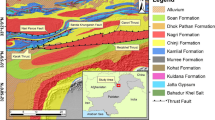Abstract
In an effort to quantify the geogenic radon soil–gas potential and appraise the use of radon technique as a geological mapping tool in a crystalline basement rock terrain of Ile–Ife Nigeria, radon measurement concentration were made using a radon detector instrument (EDA RD-200) that measures radon isotopes by a scintillator cell coupled to a photomultiplier tube. The data were collected from soils derived from three different lithologic rock units. The observed values were then correlated with the geology of the area. Significant differences in the radon soil–gas concentrations among the three geologic units were observed. Granite gneiss has the highest concentration, followed by grey gneiss and mica schist in that order. The geometric mean (GM) concentration of radon-222 measured in soils directly overlying the three different rock types were 301.4 pCi/l for granite gneiss, 202.8 pCi/l for the grey gneiss, and 199.4 pCi/l for mica schist. Conversely, the average values for radon-220 averaged 1510.0, 815.4, and 733.0 pCi/l for granite gneiss, grey gneiss, and mica schist rocks, respectively. Statistical t test (α=0.05) results indicated that there was no significant difference in the geometric mean of radon soil–gas measured between low and medium potential zones. However, significant differences were found between the low and high radon potential zones, and between the medium and high zones. The low concentrations of radon soil–gas emission observed in this study is explained in terms of the seasonal variation due to thermal convection fluid movement, while the radon concentrations were found to be controlled by the lithology and geochemistry of the underlying bedrock.







Similar content being viewed by others
References
Adepelumi AA, Ako BD, Ajayi TR (2001) Groundwater contamination in the basement-complex area of Ile–Ife, SW Nigeria: a case study using the electrical-resistivity geophysical method. J Hydrogeol 9:611–622
Ajayi TR, Adepelumi AA (2002) Reconnaissance soil–gas radon survey over the faulted crystalline area of Ile–Ife, Nigeria. Environ Geol 41:608–613
Ajibade AC, Woakes M, Rahaman MA (1987) Proterozoic crustal development in the Pan-African regime of Nigeria. Am Geophys Union 17:259–271
Akinloye MA, Olomo JB, Olubunmi PA (1999) Meat and poultry consumption contribution to the natural radionuclide intake of the inhabitants of the Obafemi Awolowo University, Ile–Ife, Nigeria. Nucl Instrum Methods Phys Res A422:795–800
Boesse JM (1989) A geologic map of the Obafemi Awolowo University campus. Unpublished report of Obafemi Awolowo University, Ile–Ife, Nigeria, vol 1, pp 1–20
Caby R, Boesse JM (2001) Pan-African nappe system in southwest Nigeria: the Ife–llesha schist belt. J Afr Earth Sci 33:211–225
Choubey VM, Sharma KK, Ramola RC (1997) Geology of radon occurrence around Jari in Parvati Valley, Himachal Pradesh, India. J Environ Radioact 34:139–147
Choubey VM, Bist KS, Saini NK, Ramola RC (1999) Relation between soil–gas radon variation and different lithotectonic units, Garhwal Himalaya, India. Appl Radiat Isot 51:587–592
DOE (1988) Radon epidemiology. A guide to the literature. Literature Survey Series. US Department of Energy, Office of Energy Research, DOE/ER-0399
Etiope G, Martinelli G (2002) Migration of carrier and trace gases in the geosphere: an overview. Phys Earth Planet Inter 129:185–204
Gunby JA, Darby SC, Miles JCH, Green BMR, Cox DR (1993) Factors affecting indoor radon concentrations in the United Kingdom. Health Phys 64:2–12
Hubbard LM, Hagberg N (1996) Time variation of the soil gas radon concentration under and near a Swedish house. Environ Int 22(Suppl 1):S477–S482
Kemski J, Klingel R, Siehl A (1996) Classification and mapping of radon affected areas in Germany. Environ Int 22:789–798
Klausman RW, Jaacks JA (1987) Environmental influences upon mercury, radon and helium concentration in soil gases at a site near Denver Colorado. J Geochem Explor 27:259–280
Merrill AE, Farhang AK (1998) Diurnal and seasonal variations of radon levels, effects of climatic conditions, and radon exposure assessment in a former Uranium metal production facility. Health Phys 74:568–573
Mogro-Campero A, Fleischer RL (1977) Subterrestrial fluid convection: a hypothesis for long distance migration of radon within the earth. Earth Planet Sci Lett 34:321–325
Nero AV, Nazaroff WW (1984) Characterising the source of radon indoors. Radiat Prot Dosim 7:23–29
Rahaman MA (1988) Recent advances in the study of the basement complex of Nigeria. In: Oluyide PO, Mbonu, WC, Ogezi AE, Egbnike IG, Ajibade AC, Ana-Umeji AC (eds) Precambrian geology of Nigeria. Geological Survey of Nigeria Publication, pp 11–43
Reimer GM (1990) Reconnaissance techniques for determining soil–gas radon concentrations: an example from Prince Georges Country, Maryland. Geophys Res Lett 17:809–812
Singh M, Singh NP, Singh S, Virk HS (1986) Calibration of radon detectors. Nucl Tracks 12:739–742
Tanner AB (1986) Indoor radon and its sources in the ground: US Geological Survey Open File Report 86-222, p 5
US EPA (1993) Radon, the Health Threat with a simple Solution, a Physician’s Guide. 402-K-93-008
US EPA (1994) A citizen’s guide to Radon, 2nd edn. The guide to protecting yourself and your family from radon. Office of radiation and indoor Air. EPA-402-K92-001
Acknowledgements
The first author is grateful to the South Korean government for granting him a post-doctoral fellowship that enabled him to carry out the research at the Korea Institute of Geoscience and Mineral Resources, Daejeon, South Korea. The counting equipment used for this work was a donation from the IAEA, Austria. The authors are deeply grateful for these supports.
Author information
Authors and Affiliations
Corresponding author
Rights and permissions
About this article
Cite this article
Adepelumi, A.A., Ajayi, T.R., Ako, B.D. et al. Radon soil–gas as a geological mapping tool: case study from basement complex of Nigeria. Environ Geol 48, 762–770 (2005). https://doi.org/10.1007/s00254-005-0016-0
Received:
Accepted:
Published:
Issue Date:
DOI: https://doi.org/10.1007/s00254-005-0016-0




